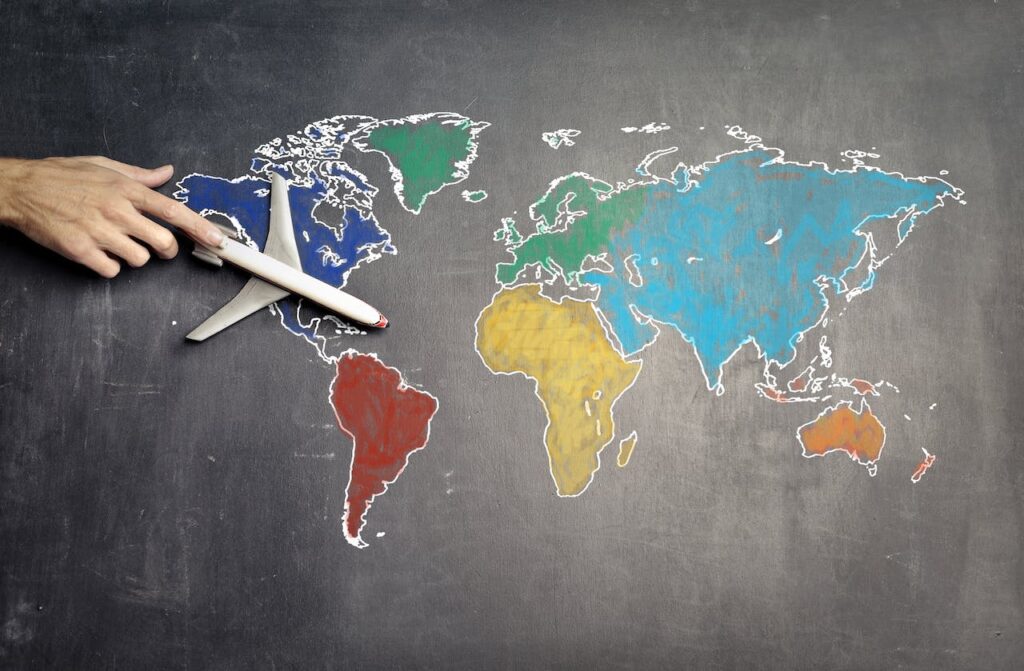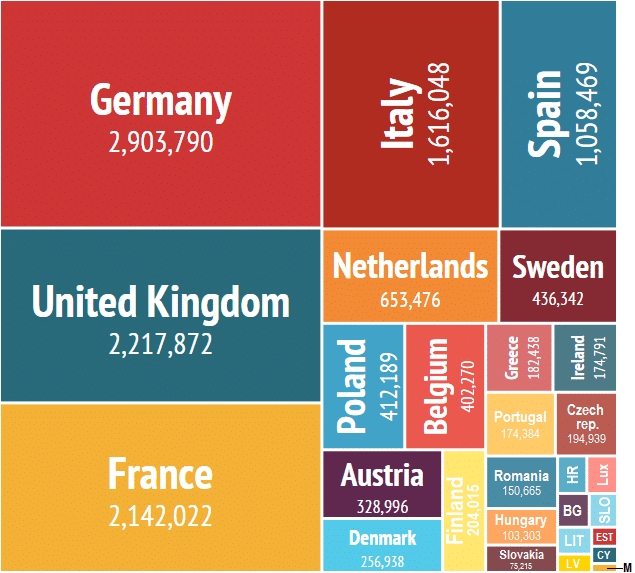
The 12 Best Languages for Business in 2024
The business world is becoming a tougher place every day for monolinguals.
The most successful CEOs of the 21st century are presenting business plans in Mandarin and dialing into conference calls in French.
Nowadays business is global. Investors in South Korea and Egypt are funding startups in Chile and the Netherlands, who work with contractors in Kenya and the Philippines and sell to clients in Turkey and Bahrain.
So if you’re asking yourself, “what language should I learn?” and if you’re preparing to invest in your financial future with a new language, forget about the typical top 10 lists.
Instead, you’ve got to think about your investment’s future: What are the fastest-growing languages, and what’s the language of choice for the up-and-coming power players of tomorrow?
Read on for the 12 best languages to learn for business today and in the future.
Contents
- 1. Portuguese: Doing Business Across Four Continents
- 2. Cantonese: Money Talks in Southeast Asia
- 3. Urdu: The Language of Emerging Markets
- 4. Spanish: Anything but Business as Usual in Latin America
- 5. German: The Language of European Industrial Might
- 6. Arabic: The Web’s Fastest-growing Language
- 7. Mandarin: The Language That’s Dying to Spend Its Money
- 8. English: The Language of Globalization
- 9. Japanese: East Asia’s Tiger Economy
- 10. Russian: the Northern Giant
- 11. Hindi: South Asia’s Hindu Power Player
- 12. Indonesian: the Up and Coming Pacific Island Nation
- And One More Thing...
Download: This blog post is available as a convenient and portable PDF that you can take anywhere. Click here to get a copy. (Download)
1. Portuguese: Doing Business Across Four Continents

Number of speakers: 221 million
Where it’s spoken: Portugal, Brazil, Mozambique, Angola, Cape Verde, Guinea-Bissau and São Tomé and Príncipe.
Main business conducted in Portuguese: Agriculture, mining, tourism, infrastructure, textiles, renewable energy
Only about 4% of the world’s Portuguese speakers are in the language’s namesake country; the rest are scattered across some of today’s fastest growing populations and economies.
The Lusophone (Portuguese-speaking) giant we all know and love is of course Brazil. The country that put the B in the BRICS countries—the four other countries plus Brazil that together make up the biggest, baddest, boomingest economies—is spending countless reais to influence the world and the way it does business.
Under Brazil’s economic influence, Portuguese is likely to compete with or even displace English as the most important foreign language in South America. It’s the revving engine of the MERCOSUR trade bloc, whose combined GDP of $4 trillion US dollars makes it a player of global proportions.
But don’t be distracted by the headliner: Portuguese-speaking Angola is an oil-rich African nation that’s rapidly developing and Macau, Hong Kong’s often overlooked sister “special administrative region” of China which is also a former Portuguese colony, is the fastest-growing economy in the entire world.
From Brasília and São Paulo to Lisbon, Luanda, Goa and Macau, Portuguese has spread itself across established power centers and up-and-comers both, making it one of today’s smartest long-term investments for language learners.
2. Cantonese: Money Talks in Southeast Asia

Number of speakers: 66 million
Where it’s spoken: Guangdong and Guangxi provinces of southeastern China, as well as in Hong Kong and Macau
Main business conducted in Cantonese: Trade, manufacturing, finance, technology, education services
Speaking of Macau’s neighbor across the bay, Hong Kong is one of the four East Asian Tigers that dominate the economics of the East. Like its neighbor and fellow Tiger Singapore, the de facto language of daily life is Cantonese rather than the Mainland’s favored Mandarin.
In Hong Kong, Singapore and other key financial centers in southern China like Guangzhou, Cantonese is the language of choice. 60 million people throughout Southeast Asia and southern China are taking care of business in Cantonese, which spells opportunity for business-savvy language learners.
What’s more, Cantonese has spread across most of the world in a unique way. Most Chinese immigrants to Western countries in the 20th century came from the Cantonese-speaking Guangdong area, resulting in Cantonese rather than Mandarin becoming the lingua franca of Chinatowns from Vancouver to London and most places in between.
Add to that the fact that the large Chinese enclaves in Vietnam, Malaysia and other pockets of Southeast Asia are also primarily Cantonese-speaking, and you’ve got a formidable linguistic tool for doing business throughout the world.
3. Urdu: The Language of Emerging Markets

Number of speakers: 260 million
Where it’s spoken: Urdu is the official language of Pakistan and one of the 22 scheduled languages of India. It is also widely spoken and understood in communities with South Asian diaspora, especially in countries with significant Pakistani and Indian populations
Main business conducted in Urdu: Textiles and apparel, agriculture and information technology (IT)
China normally steals the spotlight in The Wall Street Journal and the Financial Times, but just to the south the Indian subcontinent and its 1.5 billion inhabitants are shaking up the system.
By 2030, India is projected to be the world’s largest country by population, and neighboring Pakistan will hold the number six spot, combining to total a whopping population of 1.75 billion just 15 years down the road.
English fluency is high in this part of the world, but never underestimate the impact of learning the local language. Pakistan and most of its 200 million inhabitants speak Urdu, the national language, which spills over into the homes and businesses of 50 million more people in India. With nearly 5% growth per year, Pakistan is designated one of the Next Eleven economies which promise bountiful business opportunities in the near future.
Even better, Urdu is mutually intelligible with Hindi, and linguists often consider the two to be dialects of one language called Hindustani. Estimates of the total number of Hindustani speakers range from 400 to 500 million, making it by any count one of the world’s largest languages.
With Karachi’s $78 billion market looking to invest in its workforce and technology, it’s easy to see why Urdu’s stock is soaring.
4. Spanish: Anything but Business as Usual in Latin America

Number of speakers: 580 million
Where it’s spoken: Spain, Mexico, Argentina, Colombia, Chile, Peru, Venezuela, Ecuador, Guatemala, Cuba, Bolivia, Dominican Republic, Honduras, Paraguay, El Salvador, Nicaragua, Costa Rica, Puerto Rico, Panama, Uruguay.
Main business conducted in Spanish: Tourism, agriculture, automotive, technology, mining, communications, transport, textiles and apparel
Two of today’s G20 major economies, Argentina and Mexico, are Spanish-speaking. These Latin American powerhouses are well-established global forces, but they no longer tell the entire story of how business is done in Latin America.
Inconspicuous economies like Chile, Peru and Colombia are quietly pushing forward through initiatives like the Trans-Pacific Partnership and successful measures to reduce corruption and violence in their countries. These growth-leaders will almost certainly bring unprecedented cash flows not only into their own borders, but also to their neighbors through trade unions like MERCOSUR and the Andean Community of Nations.
The other Spanish-speaking G20 country that is too often overlooked on a list like this, the country with the #2 hispanohablante population in the world, is the United States. English is the first language that comes to mind when the USA is named, but its 50 million Spanish speakers and their small and large businesses might kindly remind you that it’s not the only language spoken in the country.
If you’re one of the 90 million learners worldwide who’s already picked up some Spanish, try brushing up on your business Spanish to stay on the cutting edge of the business world.
5. German: The Language of European Industrial Might

Number of speakers: 100 million
Where it’s spoken: Germany, Austria, Switzerland, Liechtenstein, Luxembourg, Italy (South Tyrol), Namibia, Paraguay.
You’d be hard-pressed to overestimate Germany’s economic impact on the affairs of the European Union.
Europe’s largest economy is also the fifth largest in the world: 80 million industrious Germans make up one percent of the global population, yet they generate an astounding 4.5% of global GDP.

By Jonas Henriksson (Own work) [CC BY-SA 4.0 (http://creativecommons.org/licenses/by-sa/4.0)], via Wikimedia Commons
This and the fact that Frankfurt is home to the European Central Bank is a sure sign that German for business will only continue to grow in importance in the business world.
But, as with many of the other languages on this list, it’s not just the country that gives the language its name that holds the brightest business prospects. German-speaking Austria is another dynamic European economy, and Swiss banks still save and spend their dollars and francs in Deutsch.
To language learners, German might at times sound like an angry chest cold, but to the business leaders and deal closers of Europe, it sounds like money.
6. Arabic: The Web’s Fastest-growing Language

Number of speakers: 310 million
Where it’s spoken: Algeria, Bahrain, Comoros, Djibouti, Egypt, Iraq, Jordan, Kuwait, Lebanon, Libya, Mauritania, Morocco, Oman, Palestine, Qatar, Saudi Arabia, Somalia, Sudan, Syria, Tunisia, United Arab Emirates, and Yemen.
Main business conducted in Arabic: Oil and gas, technology, real estate, finance, telecommunications
If you turn on the news today, you might make the mistake of associating Arabic with conflict and violence. You’d only be seeing a small sliver of what’s going on in the homes, offices and bank accounts of the world’s nearly 300 million Arabic speakers. Instead, take a glance at Twitter or the latest global financial news and you’ll find a different story.
Ever since social media catalyzed democratic revolutions in the Arab Spring starting in 2010, Arabic has been the fastest-growing language on the worldwide web. To be exact, online use of Arabic has grown by 2500% in the last ten years, compared to 743% for Spanish and 281% for English.
A quick investigation will show you why. In the United Arab Emirates, multi-billion dollar oil deals are arranged in Arabic. In Cairo, it’s the language of one of the world’s most massive film and television industries. In Doha, stock traders shout to buy or sell in Arabic in the Qatar Stock Exchange. In Beirut, it’s the language used to advertise the chic high-end fashion of the Middle East.
And here’s the real news: As of 2013, only about a third of the world’s 300 million Arabic speakers were online. That means there’s plenty more room to grow, which should scream opportunity to language learners with an interest in the Middle East.
7. Mandarin: The Language That’s Dying to Spend Its Money

Number of speakers: Around one billion
Where it’s spoken: China, Taiwan, Singapore, Malaysia, Indonesia, Thailand, Philippines, United States, Canada, Australia, New Zealand and in various Chinese diaspora communities in countries worldwide
Main business conducted in Mandarin: Trade and manufacturing, real estate, technology, finance and banking
Ah yes, there’s the Chinese language you thought you’d find on this list.
It’s the one that you just can’t miss when talking about the best languages for business, the duh candidate with its billion plus speakers and largest purchasing power in the world. In fact, we can’t think of a single reason a budding entrepreneur shouldn’t learn Mandarin (it’s really not as hard as they say).
The reason this language will only continue to become even more important is because of the nearly mythical economic shift taking place in China. In about 30 years, the country went from one of the poorest countries in the world to its largest middle class. And one of the key factors of any consumer segment labeled “middle class” is its disposable income. The newly wealthy are adding to their numbers daily in China, and all those yuan are burning holes in their pockets.
8. English: The Language of Globalization

Number of speakers: 1.5 billion
Where it’s spoken: United States, United Kingdom, Canada, Australia, New Zealand, Ireland, South Africa, India, Singapore, Malaysia, Philippines, Nigeria, Kenya, Ghana, Jamaica, Trinidad and Tobago, Barbados, Bahamas, Antigua and Barbuda, Belize, Grenada, Saint Lucia, Saint Vincent and the Grenadines, Dominica, Saint Kitts and Nevis.
Main business conducted in English: Technology and innovation, finance and banking, entertainment and media
English is the official language of 67 countries and 27 territories, as well as all of the most important global institutions like the UN, the European Union, NATO and the OECD. With over 350 million native speakers and a mind-blowing 500 million second language speakers in the world, English permeates nearly every aspect of global society, from Wall Street and London to the Internet and international governance.
And there doesn’t appear to be an economist, entrepreneur or linguist on the map who thinks the unstoppable tide of English will do anything but continue to gain momentum. The British Council predicts that the total number of people learning English will exceed 1.9 billion by the year 2020. That’s in addition to the growing population of native speakers, and 2020 is a short four years away.
With the evergreen importance of English in business and life, congratulate yourself on reading this article in the world’s most widely-spoken language, but don’t stop there. Business English is a rapidly growing field, and rightly so. The way we talk to colleagues and boards of directors bears little resemblance to the language we use in classrooms, cafes and social gatherings.
9. Japanese: East Asia’s Tiger Economy

Number of speakers: 127 million
Where it’s spoken: Japan
Main business conducted in Japanese: Automotive, electronics and technology, manufacturing and robotics
Japanese holds considerable significance in the global business arena, particularly due to Japan’s status as a major economic powerhouse.
Japan boasts a Gross Domestic Product (GDP) that consistently ranks among the top five globally. In 2021, Japan was the third-largest economy in the world, underscoring its economic influence.
Many Japanese corporations, such as Toyota, Sony and Mitsubishi, are leaders in various industries and have a substantial international footprint.
Proficiency in Japanese can be instrumental for individuals engaged in sectors like automotive, technology, and manufacturing, as it fosters effective communication and relationship-building with Japanese counterparts.
Moreover, Japan is known for its unique business culture, where language nuances play a crucial role. Understanding Japanese etiquette and language intricacies becomes essential for successful negotiations and partnerships. In the dynamic landscape of global business, being conversant in Japanese provides a competitive edge, facilitating cross-cultural collaboration and paving the way for business success on the international stage.
10. Russian: the Northern Giant

Number of speakers: 258 million
Where it’s spoken: Russia, Belarus, Kazakhstan, Kyrgyzstan, Ukraine, Estonia, Latvia, Lithuania, Armenia, Azerbaijan, Georgia, Uzbekistan, Turkmenistan, Moldova, Israel, Germany, United States, Canada, Brazil.
Main business conducted in Russian: Energy and natural resources, metals and mining, finance and banking
Russian plays a noteworthy role in the realm of global business, especially considering Russia’s significant presence in various industries and its rich natural resources.
While English is commonly used as the global business language, having proficiency in Russian can be a strategic advantage, particularly when engaging with Russian corporations and markets.
According to the World Bank, Russia is the eleventh-largest economy globally by nominal GDP, highlighting its economic importance. Many multinational companies operate in Russia, and understanding the Russian language facilitates smoother communication and negotiations.
Additionally, Russia is a key player in the energy sector, being one of the world’s largest oil and natural gas exporters. As of recent data, Russia is the top exporter of natural gas, supplying a substantial portion of Europe’s energy needs.
Therefore, a grasp of Russian can be valuable for professionals involved in energy-related businesses.
11. Hindi: South Asia’s Hindu Power Player

Number of speakers: 310 million
Where it’s spoken: India, Nepal, Fiji, Trinidad and Tobago, Guyana, Suriname, Mauritius, South Africa, United States, Canada, United Kingdom, Australia.
Main business conducted in Hindi: Information technology (IT) and software services, retail and consumer goods, telecommunications
Hindi, the official language of India, plays a significant role in global business given India’s substantial economic impact and its status as one of the world’s fastest-growing major economies.
With a GDP that consistently ranks in the top ten globally, India offers diverse business opportunities across sectors such as information technology, pharmaceuticals and telecommunications. In 2021, India was the sixth-largest economy in the world by nominal GDP, showcasing its economic prowess.
Proficiency in Hindi is advantageous for international business professionals looking to engage with Indian companies, negotiate deals and navigate the Indian market. As a country with a rapidly expanding consumer base, India attracts numerous multinational corporations.
Hindi is not only a language but also a key to understanding the cultural nuances that influence business interactions in India. Given its widespread use in government, media and business, Hindi fluency enhances communication and fosters relationships in this dynamic and vibrant market, contributing to success in the global business landscape.
12. Indonesian: the Up and Coming Pacific Island Nation

Number of speakers: 270 million
Where it’s spoken:
Main business conducted in Indonesian: Palm oil and agribusiness, telecommunications and digital services, natural resources and mining
Indonesian holds strategic importance in the global business landscape due to Indonesia’s growing economic significance and its position as a key player in Southeast Asia.
As the largest economy in the region, Indonesia plays a vital role in various industries, including natural resources, manufacturing, and services. In terms of GDP, Indonesia consistently ranks as one of the top 20 economies worldwide.
The archipelago nation’s economic expansion, driven by a burgeoning middle class and investment-friendly policies, presents attractive opportunities for international business.
Proficiency in Indonesian is advantageous for those seeking to navigate the local business environment, establish partnerships, and tap into Indonesia’s diverse market. With a population exceeding 270 million, Indonesia boasts a substantial consumer base, making it an appealing destination for multinational corporations.
Understanding the language is not only a practical necessity but also a cultural key to successful business interactions. In the dynamic Southeast Asian market, where relationships are highly valued, the ability to communicate in Indonesian can open doors and contribute significantly to business success on the global stage.
FluentU takes authentic videos—like music videos, movie trailers, news and inspiring talks—and turns them into personalized language learning lessons.
You can try FluentU for free for 2 weeks. Check out the website or download the iOS app or Android app.
P.S. Click here to take advantage of our current sale! (Expires at the end of this month.)
These are 12 of the best and most practical languages for the innovators, investors and in-the-know business women and men of the coming years, but it couldn’t be further from an exclusive list.
What matters is that you learn another language and, hopefully, along with it, another culture. Business life went global years ago, and now our personal lives are becoming more and more global by the day, which makes it all the more important to learn a foreign language and become a better participant in global society.
Download: This blog post is available as a convenient and portable PDF that you can take anywhere. Click here to get a copy. (Download)
And One More Thing...
If you dig the idea of learning on your own time from the comfort of your smart device with real-life authentic language content, you'll love using FluentU.
With FluentU, you'll learn real languages—as they're spoken by native speakers. FluentU has a wide variety of videos as you can see here:
FluentU has interactive captions that let you tap on any word to see an image, definition, audio and useful examples. Now native language content is within reach with interactive transcripts.
Didn't catch something? Go back and listen again. Missed a word? Hover your mouse over the subtitles to instantly view definitions.
You can learn all the vocabulary in any video with FluentU's "learn mode." Swipe left or right to see more examples for the word you’re learning.
And FluentU always keeps track of vocabulary that you’re learning. It gives you extra practice with difficult words—and reminds you when it’s time to review what you’ve learned. You get a truly personalized experience.
Start using the FluentU website on your computer or tablet or, better yet, download the FluentU app from the iTunes or Google Play store. Click here to take advantage of our current sale! (Expires at the end of this month.)






